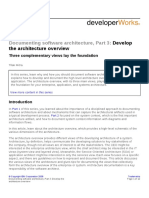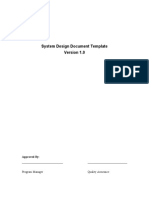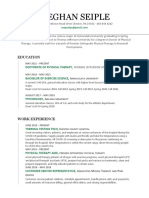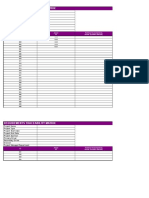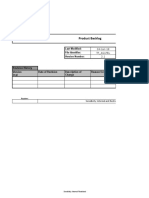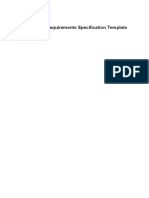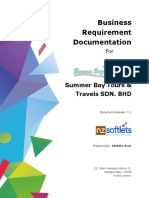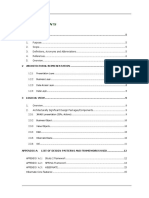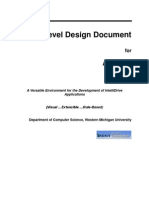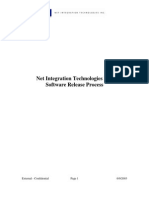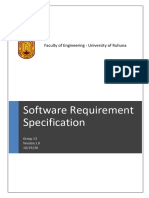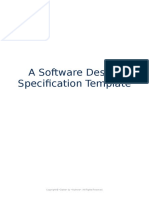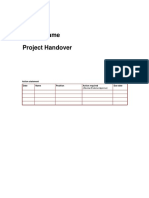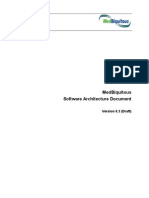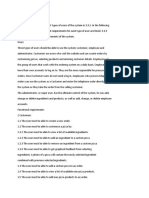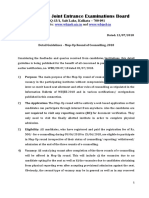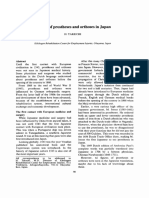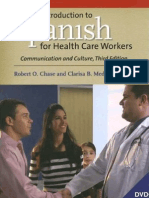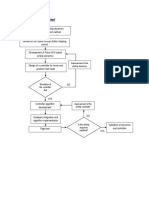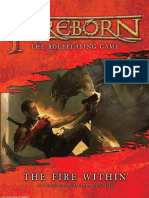SRS Document For Review
SRS Document For Review
Uploaded by
Kunal ChowdhuryCopyright:
Available Formats
SRS Document For Review
SRS Document For Review
Uploaded by
Kunal ChowdhuryOriginal Title
Copyright
Available Formats
Share this document
Did you find this document useful?
Is this content inappropriate?
Copyright:
Available Formats
SRS Document For Review
SRS Document For Review
Uploaded by
Kunal ChowdhuryCopyright:
Available Formats
Example Software Requirements
Specification Document for
ReqView
Libor Buš, Eccam s.r.o.
12.6.2019
© Copyright 2019 by Eccam s.r.o. All rights reserved.
Example Software Requirements Specification Document for ReqView
Table of Contents
1. Introduction .................................................................................................................... 3
1.1 Purpose ........................................................................................................................................ 3
1.2 Scope ........................................................................................................................................... 3
1.3 Product perspective..................................................................................................................... 3
1.4 Product functions ........................................................................................................................ 4
1.5 User characteristics ..................................................................................................................... 4
1.6 Limitations ................................................................................................................................... 4
1.7 Assumptions and dependencies .................................................................................................. 4
1.8 Definitions ................................................................................................................................... 4
1.9 Acronyms and abbreviations ....................................................................................................... 4
2. Requirements .................................................................................................................. 5
2.1 External interfaces ....................................................................................................................... 5
2.2 Functions ..................................................................................................................................... 5
2.3 Usability requirements .............................................................................................................. 10
2.4 Performance requirements ....................................................................................................... 10
2.5 Logical database requirements ................................................................................................. 10
2.6 Design constraints ..................................................................................................................... 10
2.7 Standards compliance ............................................................................................................... 10
2.8 Software system attributes ....................................................................................................... 10
3. Verification .................................................................................................................... 11
4. Supporting information.................................................................................................. 11
5. References ..................................................................................................................... 11
Revision History
Name Date Reason For Changes Version
Libor Buš June 10, Export of Demo Software Requirements 1
2016 Specification from ReqView 2.1.0
Libor Buš June 12, Export of Demo Software Requirements 2
2019 Specification from ReqView 2.6.2
© Copyright 2019 by Eccam s.r.o. All rights reserved. 2
Example Software Requirements Specification Document for ReqView
1. Introduction
1.1 Purpose
This document specifies a simplified subset of ReqView version 1.0 functionality
allowing users to capture requirements in a single structured requirement specification
document.
Note: This is an example document, which is not complete.
The main purpose of this document is to provide new ReqView users a working
example of a Software Requirements Specification (SRS) based on ISO/IEC/IEEE
29148:2018 Standard.
1.2 Scope
The application allows users to:
• Capture structured requirements specifications describing textual requirements
• Assign requirements custom attributes
• Link related requirements
• Comment requirements
• Filter and search requirements
• Import requirements from MS Word or Excel
• Export documents to HTML or CSV
• Print documents
The application stores documents as human readable files with open file format.
The application runs offline without connection to any server.
1.3 Product perspective
1.3.1 System interfaces
The application runs in the latest version of Chrome or Firefox browser on Windows,
Linux and Mac.
1.3.2 User interfaces
The application GUI provides menus, toolbars, buttons, panes, containers, grids
allowing for easy control by a keyboard and a mouse.
1.3.3 Hardware interfaces
1.3.4 Software interfaces
The application allows import a structured MS Word document via HTML data format.
The application allows populating a MS Word document with project data via HTML
data format.
© Copyright 2019 by Eccam s.r.o. All rights reserved. 3
Example Software Requirements Specification Document for ReqView
The application allows import / export a list of requirements from / to MS Excel sheet via
CSV data format.
The application stores project data in JSON format to enable easy integration with 3rd
party applications.
1.3.5 Communications interfaces
1.3.6 Memory constraints
1.3.7 Operations
1.3.8 Site adaptation requirements
1.3.9 Interfaces with services
1.4 Product functions
Product functions are summarized in Section 2. User Stories of NEEDS document.
1.5 User characteristics
1.6 Limitations
1.7 Assumptions and dependencies
1.8 Definitions
Custom Attribute: Additional requirement property capturing additional requirements
properties such as requirements source, status, priority, verification method, fit criterion,
...,
Document: A structured requirements specification capturing textual requirements for a
given product or service.
Link: A directed association between related requirements allowing to analyze
requirements coverage, gaps and impact of changes.
Link Type: Property of traceability links allowing to analyze links with different semantic
independently, e.g., satisfaction and verification links.
1.9 Acronyms and abbreviations
CSV: Comma Separated Values
DNF: Disjunctive Normal Form
ID: Identifier
GUI: Graphical User Interface
HTML: Hypertext Markup Language
SRS: Software Requirements Specification
© Copyright 2019 by Eccam s.r.o. All rights reserved. 4
Example Software Requirements Specification Document for ReqView
2. Requirements
2.1 External interfaces
2.2 Functions
2.2.1 File Operations
2.2.1.1 Create Document
[DEMO-SRS-53] The application shall allow users to create a new empty document.
[DEMO-SRS-54] If the current document contains unsaved changes then the
application shall allow users to save the changes before closing the document.
2.2.1.2 Open File
[DEMO-SRS-56] The application shall allow users to open a document from a chosen
file.
2.2.1.3 Save Local File
[DEMO-SRS-59] The application shall allow users to save the opened document into a
file.
2.2.1.4 Document Template
[DEMO-SRS-61] The application shall allow users to create a document template file
from the opened document.
[DEMO-SRS-62] Document templates shall store structure of document sections and
definition and values of requirement attributes.
[DEMO-SRS-63] The application shall allow users to create a new document from a
chosen document template file preserving the structure of document sections and the
definition and values of requirement attributes.
2.2.1.5 Import
[DEMO-SRS-72] The application shall allow users to import a MS Word document
preserving structure of document sections and paragraphs, rich text description of
requirements and images.
[DEMO-SRS-73] The application shall allow users to import a MS Excel table of
requirements preserving section headings, levels, unformatted text description of
requirements and values of custom attributes.
2.2.1.6 Export
[DEMO-SRS-76] The application shall allow users to export the displayed document
view to HTML.
[DEMO-SRS-77] The application shall allow users to export requirements to CSV.
2.2.2 Document View
© Copyright 2019 by Eccam s.r.o. All rights reserved. 5
Example Software Requirements Specification Document for ReqView
2.2.2.1 Table of Contents
[DEMO-SRS-80] The application shall display the table of contents containing section
headings organized according to their document tree hierarchy.
[DEMO-SRS-81] When user clicks on a document section in the table of contents then
the application shall focus the section in the requirements table.
2.2.2.2 Requirements Table
[DEMO-SRS-83] The application shall display the document in a requirements table
containing the following columns: ID, Description, Discussion, Links and a column for
each custom requirement attribute.
[DEMO-SRS-84] The ID column of the requirements table shall display unique
requirement identifiers.
[DEMO-SRS-85] The Description column of the requirements table shall display the
section numbers, headings, requirement text descriptions and attachments.
[DEMO-SRS-86] The Discussion column of the requirements table shall display
requirement comments with information about comment author, date and text ordered
by date and time.
[DEMO-SRS-87] The Links column of the requirements table shall display requirement
traceability links grouped by link types.
[DEMO-SRS-88] The application shall allow users to change width of each
requirements table column.
[DEMO-SRS-190] The application shall allow users to reorder requirements table
columns.
[DEMO-SRS-89] The application shall allow users to show and hide requirements table
columns except the ID column.
[DEMO-SRS-90] The application shall allow users to sort all requirements table
columns except the Discussion and Links columns by ascending or descending order.
2.2.2.3 Detailed Information
[DEMO-SRS-92] The application shall allow users to show and hide a pane displaying
detailed information about custom attributes, discussion, traceability links or history of
changes of the selected requirement.
[DEMO-SRS-93] While the custom attributes pane is shown, the application shall
display values of all assigned custom attributes for the selected requirement.
[DEMO-SRS-94] While the discussion pane is shown, the application shall display all
comments for the selected requirement ordered by date and time.
[DEMO-SRS-96] While the discussion pane is shown, the application shall allow users
to expand or collapse a selected comment or all displayed comments.
[DEMO-SRS-97] While a displayed discussion comment is expanded, then the
application shall display the date, time, author and description of the comment.
© Copyright 2019 by Eccam s.r.o. All rights reserved. 6
Example Software Requirements Specification Document for ReqView
[DEMO-SRS-98] While a displayed discussion comment is collapsed, then the
application shall display the date, time and author of the comment.
[DEMO-SRS-99] While the links pane is shown, the application shall display all
traceability links starting in or leading to the selected requirement grouped by link types
and ordered by ID of the linked object.
[DEMO-SRS-142] When user clicks on a traceability link then the application shall focus
the linked requirement.
2.2.3 Edit Document
2.2.3.1 Document Structure
[DEMO-SRS-106] The application shall allow users to create a new requirement and
place it in any document section.
[DEMO-SRS-107] When users creates a new requirement the application shall assign it
a unique ID which cannot be changed.
[DEMO-SRS-108] The application shall allow users to copy selected requirements or
document sections within the document.
[DEMO-SRS-109] The application shall allow users to move selected requirements or
document sections within the document.
[DEMO-SRS-110] The application shall allow users to mark selected requirements or
document sections as deleted.
[DEMO-SRS-111] The application shall allow users to undelete selected deleted
requirements or document sections.
[DEMO-SRS-112] The application shall allow users to permanently remove selected
deleted requirements or document sections from the document.
2.2.3.2 Requirement Attributes
[DEMO-SRS-114] The application shall allow users to edit the heading of the selected
section.
[DEMO-SRS-115] The application shall allow users to edit the text description of the
selected requirement.
[DEMO-SRS-116] The application shall allow users to paste an HTML content copied
from MS Word, Excel or other application into the text description of the selected
requirement.
2.2.3.3 Custom Attributes
[DEMO-SRS-119] The application shall allow users to define custom requirement
attributes and assign them a unique ID which cannot be changed.
[DEMO-SRS-121] The application shall allow users to set a type of each custom
attribute as follows: boolean, integer number, real number, string, date, enum or
XHTML.
© Copyright 2019 by Eccam s.r.o. All rights reserved. 7
Example Software Requirements Specification Document for ReqView
[DEMO-SRS-191] The application shall allow users to set one or more values for
custom attributes of enumeration type.
[DEMO-SRS-122] When a user changes the type of a custom attribute then the
application shall automatically convert all values of the attribute to the new type.
[DEMO-SRS-157] If the automatic conversion fails for any attribute value, then the
application shall prevent the change of custom attribute type.
[DEMO-SRS-120] The application shall allow users to set an optional name of each
custom attribute.
[DEMO-SRS-192] The application shall allow users to remove custom attributes.
[DEMO-SRS-193] When a user removes a custom attribute then the application shall
unset values of the attribute in all requirements.
[DEMO-SRS-165] The application shall allow users to edit custom attributes of the
selected requirement.
2.2.3.4 Attachments
[DEMO-SRS-124] The application shall allow users to attach one or more images or
documents (PDF, Word, Excel, Powerpoint, Visio, …) to the selected requirement.
[DEMO-SRS-126] When a new attachment is added to the document then the
application shall generate its unique attachment ID as a combination of the requirement
ID and the original attachment file name.
[DEMO-SRS-127] The application shall allow users to save attachment files to the local
file system.
[DEMO-SRS-128] The application shall allow users to update content of requirement
attachments from a selected file.
[DEMO-SRS-129] The application shall allow users to permanently remove attachments
from the document.
2.2.3.5 Comments
[DEMO-SRS-132] The application shall allow users to comment the selected
requirement.
[DEMO-SRS-133] When a user creates a new comment then the application shall
record the current date and time and the author of the comment.
2.2.3.6 Traceability Links Configuration
[DEMO-SRS-135] The application shall allow users to define link types and assign them
a unique ID which cannot be changed.
[DEMO-SRS-156] The application shall allow users to set for each link type its name
and role name of the source and target requirements.
[DEMO-SRS-138] The application shall allow users to remove link types.
© Copyright 2019 by Eccam s.r.o. All rights reserved. 8
Example Software Requirements Specification Document for ReqView
[DEMO-SRS-161] When a user removes a link type then the application shall remove
all traceability links of the link type from the document.
2.2.3.7 Traceability Links
[DEMO-SRS-137] The application shall allow users to create directed traceability links
of a chosen link type between selections of requirements or document sections.
[DEMO-SRS-139] The application shall allow users to change the link type of a selected
link traceability.
[DEMO-SRS-140] The application shall allow users to revert direction of a selected
traceability link.
[DEMO-SRS-141] The application shall allow users to permanently remove a selected
traceability link from the document.
2.2.3.8 Auto Save
[DEMO-SRS-144] The application shall automatically persist all document changes and
restore them when it is restarted.
[DEMO-SRS-160] When user closes the document the application shall clear all
persisted document data.
2.2.4 Filtering
2.2.4.1 Requirements Filter
[DEMO-SRS-147] The application shall allow users to filter requirements according to a
condition in disjunctive normal form (DNF).
[DEMO-SRS-148] The application shall allow users to enter a filtering condition
matching document sections by their number or heading.
[DEMO-SRS-149] The application shall allow users to enter a filtering condition
matching requirements by their text description or a custom attribute.
[DEMO-SRS-150] The application shall allow users to filter requirements with missing
traceability links of a given type.
2.2.4.2 Full Text Search
[DEMO-SRS-152] The application shall allow users to search requirements matching
one or more given keywords in an string or xhtml attribute.
[DEMO-SRS-153] While the search mode is active the application shall highlight the
matched requirements and allow user to select the next or previous matched
requirement in the document.
2.2.5 History of Changes
[DEMO-SRS-159] When a user changes a requirement the application shall record the
current date and time and the author of the change.
© Copyright 2019 by Eccam s.r.o. All rights reserved. 9
Example Software Requirements Specification Document for ReqView
[DEMO-SRS-101] The application shall display all changes of the selected requirement
ordered by date and time.
[DEMO-SRS-102] Each displayed requirement change shall contain author, date & time
and description of the change.
[DEMO-SRS-103] The application shall allow users to expand and collapse all changes
in the History pane.
2.2.6 Reporting
[DEMO-SRS-163] The application shall allow users to print the displayed requirements
table.
[DEMO-SRS-164] The application shall allow users to create a PDF containing the
displayed requirements table.
2.3 Usability requirements
2.4 Performance requirements
2.4.1 Startup Time
[DEMO-SRS-174] The application should display the opened document within 10s after
it is started.
2.4.2 Edit Response Time
[DEMO-SRS-171] The application should display updated values within 1s after user
triggers the edit operation.
2.4.3 Smooth Scrolling
[DEMO-SRS-173] While a user scrolls the requirements table, the application should
not display scrolling jerks longer than 200ms.
2.4.4 Document Size
[DEMO-SRS-170] The application shall allow users to open documents up to 10000
objects and 100 file attachments with total size up to 100MB.
2.5 Logical database requirements
[DEMO-SRS-194] The application shall encrypt the persistent application data.
2.6 Design constraints
2.7 Standards compliance
2.8 Software system attributes
[DEMO-SRS-195] The application shall run in the latest version of Chrome or Firefox
browsers.
[DEMO-SRS-176] The application shall not send any project data to the Internet.
[DEMO-SRS-199] The application shall sanitize any data input or imported by users.
© Copyright 2019 by Eccam s.r.o. All rights reserved. 10
Example Software Requirements Specification Document for ReqView
3. Verification
Verification tests are specified in [DEMO-TESTS] document.
4. Supporting information
5. References
[DEMO-NEEDS]: ReqView User Needs
[DEMO-TESTS]: ReqView Verification Tests
© Copyright 2019 by Eccam s.r.o. All rights reserved. 11
You might also like
- Mitsubishi Service Manual V41 ChassisDocument69 pagesMitsubishi Service Manual V41 ChassisJames Jackson100% (3)
- BRD Customer Client Sign OffDocument5 pagesBRD Customer Client Sign OffbtbowmanNo ratings yet
- Project Name Business Requirements Document (BRD) TemplateDocument29 pagesProject Name Business Requirements Document (BRD) TemplateLê Nguyên HùngNo ratings yet
- Method Statement For Access Road and Platform Construct Ion in Hilly AreasDocument7 pagesMethod Statement For Access Road and Platform Construct Ion in Hilly AreasRajesh100% (1)
- Yamaha - Service Manual - F300aDocument572 pagesYamaha - Service Manual - F300aJorge Lopes100% (1)
- Software Engineering SW ProcessDocument43 pagesSoftware Engineering SW ProcessblinNo ratings yet
- Architecture Overview DiagramDocument12 pagesArchitecture Overview DiagramCatalina Maria VladNo ratings yet
- Software Design Document (SDD) Template: IEEE STD 1016 1998Document7 pagesSoftware Design Document (SDD) Template: IEEE STD 1016 1998Dina KharistaNo ratings yet
- How To Create Requirements Traceability MatrixDocument5 pagesHow To Create Requirements Traceability MatrixAngelica Camille Mallari100% (1)
- System Design Document - SampleDocument20 pagesSystem Design Document - Sampleakshayanavo200950% (2)
- Challenges in Requirements TraceabilityDocument6 pagesChallenges in Requirements Traceabilityadvait_moghe100% (2)
- Use Case DocumentDocument6 pagesUse Case DocumentvaseemNo ratings yet
- BRD Template (2) 42325Document11 pagesBRD Template (2) 42325EmekaVictorOnyekwere100% (1)
- A Software Design Specification TemplateDocument12 pagesA Software Design Specification TemplateRana Waji Ul HassanNo ratings yet
- Meghan Seiple: EducationDocument2 pagesMeghan Seiple: Educationapi-545026502No ratings yet
- Software Testing Estimation TechniquesDocument6 pagesSoftware Testing Estimation TechniquesqabalamuraliNo ratings yet
- Software Design Description For: COMSATS University Islamabad, Park Road, Chak Shahzad, Islamabad PakistanDocument7 pagesSoftware Design Description For: COMSATS University Islamabad, Park Road, Chak Shahzad, Islamabad PakistanmanajaNo ratings yet
- Reqts Traceability Matrix TemplateDocument6 pagesReqts Traceability Matrix TemplateBrandon AtwellNo ratings yet
- Software Design Specification TemplateDocument10 pagesSoftware Design Specification TemplateDevesh Singh0% (1)
- Product Backlog: Last Modified: File Identifier: Version NumberDocument6 pagesProduct Backlog: Last Modified: File Identifier: Version Numbersomanath100% (1)
- Software Requirements Specification TemplateDocument5 pagesSoftware Requirements Specification Templatekookyymwa0% (1)
- SRS-Design and ImplementationDocument25 pagesSRS-Design and ImplementationShekhar Imvu0% (1)
- Software Requiremen Specification TemplateDocument19 pagesSoftware Requiremen Specification TemplateNhi Linh100% (1)
- Software Design SpecificationDocument2 pagesSoftware Design Specificationragamenon100% (1)
- Software Design Description For: COMSATS University Islamabad, Sahiwal Campus - PakistanDocument8 pagesSoftware Design Description For: COMSATS University Islamabad, Sahiwal Campus - PakistanMaham MalikNo ratings yet
- Software Design GuideDocument10 pagesSoftware Design GuideMykolas Banaitis100% (1)
- Software Testing Question BankDocument17 pagesSoftware Testing Question BankPusba NathanNo ratings yet
- Business Analyst Change Management in North NJ Resume Lana GropenDocument3 pagesBusiness Analyst Change Management in North NJ Resume Lana GropenLanaGropenNo ratings yet
- Software Architecture DocumentDocument9 pagesSoftware Architecture Documentram0976928No ratings yet
- Usecase RealizationDocument4 pagesUsecase RealizationNgọc Huyền NguyễnNo ratings yet
- SRS - Software Requirement SpecificationDocument5 pagesSRS - Software Requirement SpecificationMeet VaghasiyaNo ratings yet
- Project Overview ForDocument9 pagesProject Overview Forebiet98No ratings yet
- What Is A Traceability Matrix?Document5 pagesWhat Is A Traceability Matrix?mohd shanuNo ratings yet
- BRD v1.1Document129 pagesBRD v1.1Sandeep Viswanath100% (1)
- Software Design Descriptions DetailedDocument77 pagesSoftware Design Descriptions DetailedRohini Rowx100% (3)
- Example - Software Architecture DocumentDocument13 pagesExample - Software Architecture DocumentSubbu6502No ratings yet
- Software Development Life CycleDocument3 pagesSoftware Development Life CycleSriharsha Kotamarthy100% (1)
- Software High Level Design Document - SampleDocument13 pagesSoftware High Level Design Document - Samplevthh94No ratings yet
- AGORA Low Level Design Document Rev2Document53 pagesAGORA Low Level Design Document Rev2shree_mishra25No ratings yet
- Software Release ProcessDocument12 pagesSoftware Release Processermohitsehgal100% (2)
- Agile Processes ScrumDocument24 pagesAgile Processes ScrumVener GuevarraNo ratings yet
- Ystem Esign Ocument : S D D TDocument10 pagesYstem Esign Ocument : S D D Tvikram122No ratings yet
- Product BacklogDocument8 pagesProduct BacklogLê Thành DanhNo ratings yet
- EE5206 Project SRS FinalDocument106 pagesEE5206 Project SRS FinalRusham RiyasNo ratings yet
- Functional and Nonfunctional Requirements Specification and TypesDocument12 pagesFunctional and Nonfunctional Requirements Specification and TypesLokesh KNo ratings yet
- BRSDocument8 pagesBRSAngela TerrellNo ratings yet
- Software Quality: SE6121102 Pengantar Rekayasa Perangkat LunakDocument43 pagesSoftware Quality: SE6121102 Pengantar Rekayasa Perangkat LunaktumramNo ratings yet
- A Software Design Specification TemplateDocument12 pagesA Software Design Specification TemplateAkshay PrabhuNo ratings yet
- CMS System Design DocumentDocument23 pagesCMS System Design DocumentJanganMemilihOmjesNo ratings yet
- 22 Point Code Review Checklist & Process GuidelinesDocument6 pages22 Point Code Review Checklist & Process GuidelinesnyellutlaNo ratings yet
- Best Practices For Business AnalystDocument20 pagesBest Practices For Business AnalystP Rajendra100% (1)
- Key Features of Agile Software DevelopmentDocument13 pagesKey Features of Agile Software DevelopmentBalu MamidiNo ratings yet
- Use Case SpecificationDocument5 pagesUse Case SpecificationNguyễn Trung AnhNo ratings yet
- Project Name Project Handover: Action Statement Date Name Position Action Required Due DateDocument8 pagesProject Name Project Handover: Action Statement Date Name Position Action Required Due Dateanarki85No ratings yet
- OOMDDocument98 pagesOOMDRakesh K RNo ratings yet
- SRSDocument27 pagesSRSmonicatyagi6No ratings yet
- Software ArchitectureDocument17 pagesSoftware Architecturenaveenkumar321No ratings yet
- Software Requirements Specification: DwellersDocument46 pagesSoftware Requirements Specification: DwellersKonduri PrasannaNo ratings yet
- Case Study Sap FRDDocument21 pagesCase Study Sap FRDSumit NairNo ratings yet
- Software Requirements Specification Template Document For Requirements Engineers, Business Analysts, Product Managers, and DevelopersDocument16 pagesSoftware Requirements Specification Template Document For Requirements Engineers, Business Analysts, Product Managers, and DevelopersHussam MomaniNo ratings yet
- Requirements Management Plan A Complete Guide - 2019 EditionFrom EverandRequirements Management Plan A Complete Guide - 2019 EditionNo ratings yet
- DocumentDocument3 pagesDocumentKunal ChowdhuryNo ratings yet
- DocumentDocument3 pagesDocumentKunal ChowdhuryNo ratings yet
- Exam Structure of OsDocument3 pagesExam Structure of OsKunal ChowdhuryNo ratings yet
- Cheat Sheet Project Power Authority With Style PDFDocument6 pagesCheat Sheet Project Power Authority With Style PDFKunal ChowdhuryNo ratings yet
- West Bengal State University: Omputer Cience OnoursDocument2 pagesWest Bengal State University: Omputer Cience OnoursKunal ChowdhuryNo ratings yet
- Genagen CAB (Version 2013)Document2 pagesGenagen CAB (Version 2013)punyamputt2811100% (1)
- CHAPTER3 Water Flow MeasurementsDocument8 pagesCHAPTER3 Water Flow MeasurementsMel CapalunganNo ratings yet
- History of Prostheses and Orthoses in Japan: Kibikogen Rehabilitation Center For Employment Injuries, Okayama, JapanDocument6 pagesHistory of Prostheses and Orthoses in Japan: Kibikogen Rehabilitation Center For Employment Injuries, Okayama, JapanMuhammad DzulfikarNo ratings yet
- Life in Medieval Towns TextDocument10 pagesLife in Medieval Towns Textapi-233464494100% (1)
- Self Healing Technology For Asphalt PavementsDocument23 pagesSelf Healing Technology For Asphalt PavementsAhmedMahirNo ratings yet
- Account Statement For MayDocument4 pagesAccount Statement For MaygsdNo ratings yet
- Learning Plan in ResearchDocument30 pagesLearning Plan in ResearchLovely FloresNo ratings yet
- Shadow of The Wolf - Public Frame PlaytestDocument4 pagesShadow of The Wolf - Public Frame PlaytestrsdhfgngfNo ratings yet
- An Introduction To Spanish For Health Care Workers Communication and Culture, 3e (2010)Document398 pagesAn Introduction To Spanish For Health Care Workers Communication and Culture, 3e (2010)johngaltjeep100% (5)
- P2201 Operating Instruction Manual: Low Velocity Powder Actuated Fastening ToolDocument32 pagesP2201 Operating Instruction Manual: Low Velocity Powder Actuated Fastening TooleguillenNo ratings yet
- SOAL UTS 2020. B.INGGRIS XI FIKdocxDocument9 pagesSOAL UTS 2020. B.INGGRIS XI FIKdocxlatifahNo ratings yet
- Accounting FinalDocument208 pagesAccounting Finalabdul abdulNo ratings yet
- Guideline G-17 Impacto en MaterialesDocument2 pagesGuideline G-17 Impacto en MaterialesLuis OrtizNo ratings yet
- Appendix A: Research Flowchart: Improvement of The Airship DynamicsDocument2 pagesAppendix A: Research Flowchart: Improvement of The Airship DynamicsMohd Fazri SedanNo ratings yet
- Husbands and Wives 202008Document2 pagesHusbands and Wives 202008amy bartlett100% (3)
- The Millpledge Bandage Book PDFDocument64 pagesThe Millpledge Bandage Book PDFWilliams MederosNo ratings yet
- TLauncher Setup LogDocument5 pagesTLauncher Setup Logmelissa teresa bautista uwuNo ratings yet
- The Fire WithinDocument66 pagesThe Fire WithinLauraHenson100% (1)
- Kubernates-Part1Document28 pagesKubernates-Part1Sreenivas KalahastiNo ratings yet
- Research Problem, Conceptual and Theoretical FrameworkDocument22 pagesResearch Problem, Conceptual and Theoretical FrameworkAbdishakur Dahir MuseNo ratings yet
- SNMP Install and Configure Service On Windows Server and Windows 10 - 11 - Windows OS HubDocument13 pagesSNMP Install and Configure Service On Windows Server and Windows 10 - 11 - Windows OS HubinfoferhqNo ratings yet
- Tcc-5 - For Rebuilding and Protecting SteelworkDocument2 pagesTcc-5 - For Rebuilding and Protecting SteelworkMekhmanNo ratings yet
- 9781315858715Document566 pages9781315858715Priyanka Krishna100% (1)
- OrientalismDocument4 pagesOrientalismRaffat RahmanNo ratings yet
- Ti - e - Protegol 32-55 U 45 L Kartusche - Jul 08Document2 pagesTi - e - Protegol 32-55 U 45 L Kartusche - Jul 08A MahmoodNo ratings yet
- High AvailabilityDocument38 pagesHigh AvailabilityathulyabeenaraniNo ratings yet






